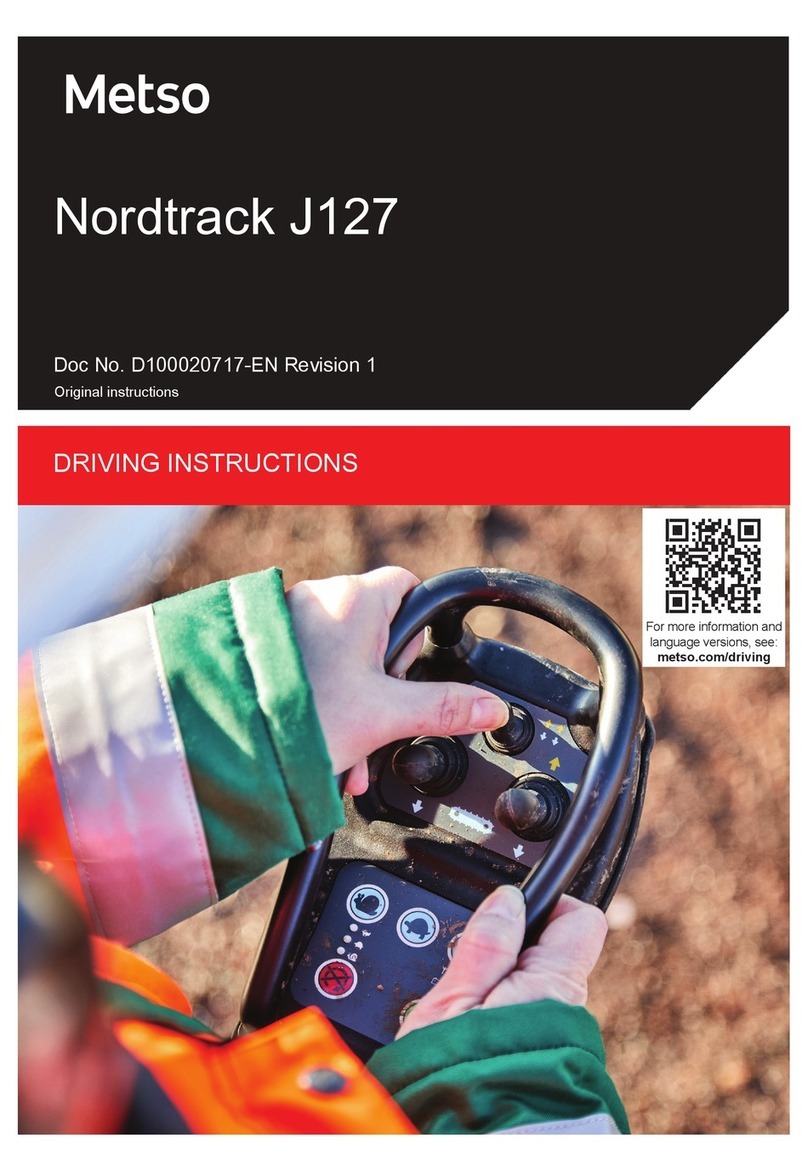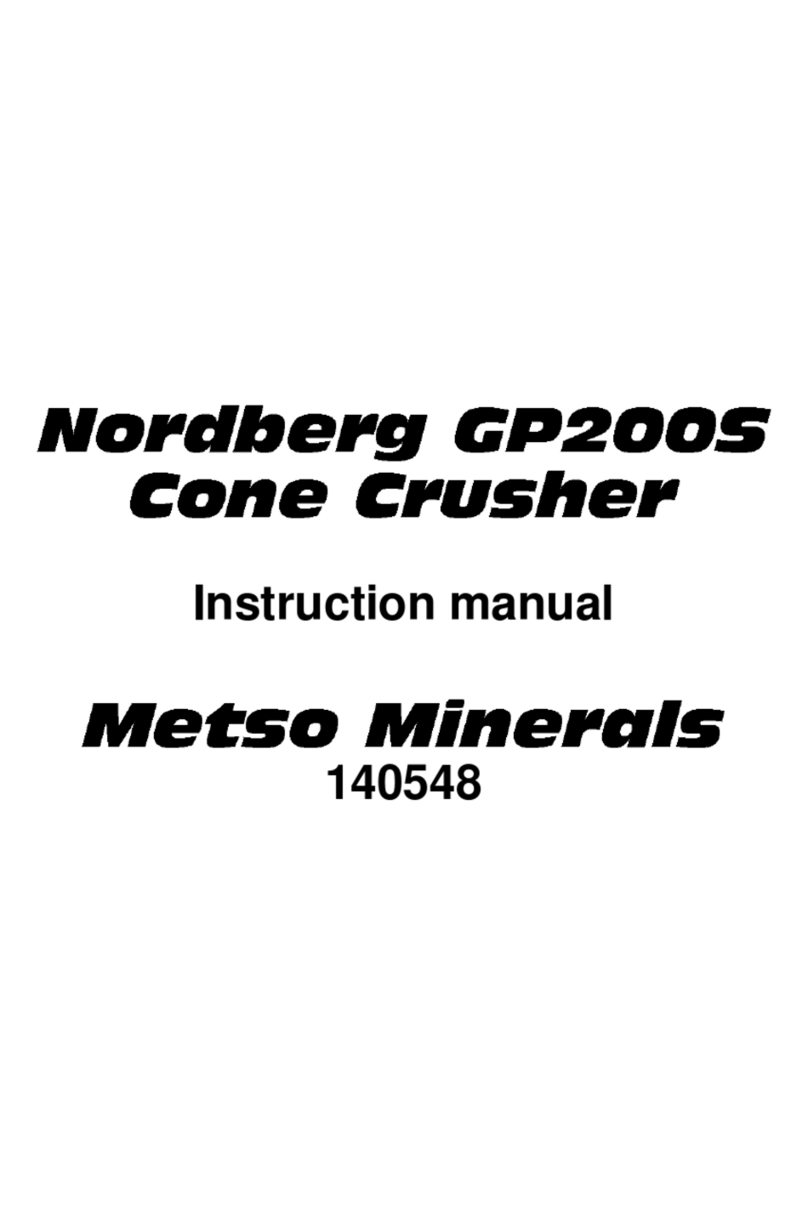Metso Nordberg MP Series Product manual

Nordberg MP Series Cone Crusher


This Technical Reference Manual provides guidance to first time operators of the Crusher as well as
providing technical procedures as a reference for the experienced crusher operator. Read — study — and
keep for future reference.
Illustrations and instructions guide the operator through correct procedures for checking, installing,
operating and maintaining the Crusher and accessories. Separate instruction manual supplements for the
lubrication system, hydraulics and crusher drive are now included in the MP Cone Crusher Technical
Reference Manual.
Operating techniques outlined in the book are basic. Operating skills and additional techniques will
develop as the operator gains knowledge of the Crusher and its capabilities.
Continuing improvement and advancement of product design may result in changes to your new machine
which may not be included in this publication, however each publication is reviewed and revised, as
required, to up-date and include appropriate changes in the later editions.
The description and specifications in this manual were in effect at the time this manual was approved for
printing. Metso Minerals reserves the right to discontinue models at any time and to change specifications
or design, without notice and without incurring obligation.
Whenever a question arises regarding your Crusher, or this publication, please consult your Metso
Minerals representative for the latest available information.
This manual is to be used as a general guide concerning technical information. All technical information
required for correct installation of your crusher must be obtained from the installation drawings and
technical data furnished for your particular Crusher.
MP®, Nordberg® and Metso Minerals® are registered trademarks of Metso Corporation.
SAFETY
Basic rules regarding safety in and around a crushing plant are outlined in Section 0,
entitled Safety of the main cone crusher instruction manual.
Operator safety and the safety of others depends upon reasonable care and judgement
in the operation of this Crusher. A careful operator is good insurance against an
accident.
Most accidents, no matter where they occur, are caused by failure to observe and
follow simple fundamental rules or precautions. For this reason most accidents can be
prevented by recognizing hazards and taking steps to avoid them before an accident
occurs.
Regardless of the care used in the design and construction of this type of equipment,
there are conditions that cannot be completely safeguarded against without interfering
with reasonable accessibility and efficient operation. Warnings are included in this
instructional manual to highlight these conditions.
FOREWORD


Table of Contents
Safety . . . . . . . . . . . . . . . . . . . . . . . . . . . . . . . . . . . . . . . . . . . . . . . . . . . . . . . . . . . . . Section 0
General Crusher Information. . . . . . . . . . . . . . . . . . . . . . . . . . . . . . . . . . . . . . . . . . . . Section 1
General Installation Information . . . . . . . . . . . . . . . . . . . . . . . . . . . . . . . . . . . . . . . . . Section 2
M. Frame, Adj. Ring, Tramp Rel. & Clrng Jack Assy . . . . . . . . . . . . . . . . . . . . . . . . . Section 3
Countershaft, Ctrshaft Box & Sheave Assemblies . . . . . . . . . . . . . . . . . . . . . . . . . . . Section 4
Eccentric Assembly. . . . . . . . . . . . . . . . . . . . . . . . . . . . . . . . . . . . . . . . . . . . . . . . . . . Section 5
Socket Assembly. . . . . . . . . . . . . . . . . . . . . . . . . . . . . . . . . . . . . . . . . . . . . . . . . . . . . Section 6
Head, Mantle and Feed Plate Assemblies . . . . . . . . . . . . . . . . . . . . . . . . . . . . . . . . . Section 7
Bowl, Bowl Liner and Hopper Assemblies . . . . . . . . . . . . . . . . . . . . . . . . . . . . . . . . . Section 8
This Section Intentionally Left Blank . . . . . . . . . . . . . . . . . . . . . . . . . . . . . . . . . . . . . . Section 9
Lubricating System . . . . . . . . . . . . . . . . . . . . . . . . . . . . . . . . . . . . . . . . . . . . . . . . . . . Section 10
Operating Instructions . . . . . . . . . . . . . . . . . . . . . . . . . . . . . . . . . . . . . . . . . . . . . . . . . Section 11
Hydraulic Systems . . . . . . . . . . . . . . . . . . . . . . . . . . . . . . . . . . . . . . . . . . . . . . . . . . . Section 12
Index . . . . . . . . . . . . . . . . . . . . . . . . . . . . . . . . . . . . . . . . . . . . . . . . . . . . . . . . . . . . . . Section I
The lubrication, hydraulic and drive supplements are now integrated in this Technical Reference manual.


Section 0
Safety
0.1 Introduction . . . . . . . . . . . . . . . . . . . . . . . . . . . . . . . . . . . . . . . . . . . . . . . . . . . . . . . . . . . . . . 0-1
0.1.1 General. . . . . . . . . . . . . . . . . . . . . . . . . . . . . . . . . . . . . . . . . . . . . . . . . . . . . . . . . . . . . . 0-1
0.1.2 Definitions: . . . . . . . . . . . . . . . . . . . . . . . . . . . . . . . . . . . . . . . . . . . . . . . . . . . . . . . . . . . 0-2
0.2 General Safety Instructions for a Crushing Plant or Plant Environment . . . . . . . . . . . . . . . . 0-3
0.2.1 Safe Products and the Crushing Plant . . . . . . . . . . . . . . . . . . . . . . . . . . . . . . . . . . . . . . 0-3
0.2.2 Safety and You . . . . . . . . . . . . . . . . . . . . . . . . . . . . . . . . . . . . . . . . . . . . . . . . . . . . . . . . 0-3
0.2.3 Typical Risks in Crushing Plant Working Environment. . . . . . . . . . . . . . . . . . . . . . . . . . 0-7
0.2.4 Personal Protective Equipment and Clothing . . . . . . . . . . . . . . . . . . . . . . . . . . . . . . . . . 0-19
0.3 Machine Safety . . . . . . . . . . . . . . . . . . . . . . . . . . . . . . . . . . . . . . . . . . . . . . . . . . . . . . . . . . . 0-22
0.3.1 Protective Devices and Accessories for Machine Safety . . . . . . . . . . . . . . . . . . . . . . . . 0-22
0.3.2 Transport . . . . . . . . . . . . . . . . . . . . . . . . . . . . . . . . . . . . . . . . . . . . . . . . . . . . . . . . . . . . 0-25
0.3.3 Towing . . . . . . . . . . . . . . . . . . . . . . . . . . . . . . . . . . . . . . . . . . . . . . . . . . . . . . . . . . . . . . 0-25
0.3.4 At the work-site . . . . . . . . . . . . . . . . . . . . . . . . . . . . . . . . . . . . . . . . . . . . . . . . . . . . . . . . 0-25
0.4 Safety During Maintenance and Repair . . . . . . . . . . . . . . . . . . . . . . . . . . . . . . . . . . . . . . . . 0-26
0.4.1 General Information and Safety Lockouts . . . . . . . . . . . . . . . . . . . . . . . . . . . . . . . . . . . 0-26
0.4.2 Mechanical Safety During Maintenance and Repair. . . . . . . . . . . . . . . . . . . . . . . . . . . . 0-27
0.4.3 Electrical Safety During Maintenance and Repair . . . . . . . . . . . . . . . . . . . . . . . . . . . . . 0-29
0.4.4 Hydraulic Safety During Maintenance and Repair . . . . . . . . . . . . . . . . . . . . . . . . . . . . . 0-30
0.4.5 General Maintenance Work . . . . . . . . . . . . . . . . . . . . . . . . . . . . . . . . . . . . . . . . . . . . . . 0-31
0.5 Safety Plates . . . . . . . . . . . . . . . . . . . . . . . . . . . . . . . . . . . . . . . . . . . . . . . . . . . . . . . . . . . . . 0-33
0.5.1 Safety Plates — ANSI. . . . . . . . . . . . . . . . . . . . . . . . . . . . . . . . . . . . . . . . . . . . . . . . . . . 0-33
0.5.2 Safety Plates — EN . . . . . . . . . . . . . . . . . . . . . . . . . . . . . . . . . . . . . . . . . . . . . . . . . . . . 0-43


MP SERIES CONE CRUSHER TECHNICAL REFERENCE MANUAL 0-1
Safety SECTION 0
0.1 INTRODUCTION
0.1.1 General
This manual, together with specific instruction
manuals for individual equipment, has been
prepared by Metso Minerals to increase the
knowledge and awareness of all persons involved
in the operation, supervision, service and
maintenance of crushing and screening equipment
with regard to safety and operations. A copy of this
manual must be provided to and studied by each
person entering the machine areas of the Crushing
Plant, or otherwise involved in the operation of the
Crushing Plant. It is the responsibility of the Owner
to always keep this manual and other written
instructions either in the Crushing Plant or its
vicinity for Operator reference.
Knowledge of the machines and the potential
hazards they present are essential to a safe
workplace. Knowledge of and compliance with all
state, provincial, and federal safety laws, safety
regulations, and Crushing Plant safety procedures,
warnings and instructions also are essential to a
safe workplace. Failure to do so can result in
serious injury or death.
When in doubt — don’t! Never bypass instructions
or procedures to save time. Never place foreign
items, tools, rods, or any part of your body into an
operating machine. Never reach over, around or
beyond safety devices. Never operate a machine if
safety devices are missing or disabled. Never
replace an OEM safety device with a non-OEM
device.
Never service equipment until all potentially
moving parts are secured and power has been
locked out and tagged out to prevent unexpected
movement.
The Operator is responsible for using care and
common sense at all times.
Remember, safety is everyone’s business. You are
responsible not only for your safety, but for the
safety of those around you.
Read this manual carefully. Know its contents. If
you have any questions, contact your Metso
Minerals representative without delay for advice.
Keep in mind that there are different types of risks,
hazards and injury types (see Section 0.2.3 Typical
Risks in Crushing Plant Working Environment),
which are related to each other. Foresee and prevent
such risks and hazards as well as resulting injuries
and other consequences from occurring by all
available means. Never compromise when the
question is safety!
Metso Minerals, as the machinery manufacturer
and supplier, regards safety as of utmost
importance, and deems the following as essential
prerequisites to the safe operation of the Crushing
Plant:
– That the Owner makes available this
manual, before using the machinery, to
each person involved with the operation,
supervision, service, or maintenance of the
Crushing Plant.
– That compliance with and adherence to
this manual be mandated and supervised
by the Owner.
– That all personnel involved in the
operation, supervision, service, or
maintenance of the Crushing Plant
become familiar with the contents of this
manual prior to such involvement.
– That every person involved in the
operation, supervision, service, or
maintenance of the Crushing Plant be
properly trained and have adequate
professional skills as required for the
performance of the respective tasks.

SECTION 0 - SAFETY
0-2 MP SERIES CONE CRUSHER TECHNICAL REFERENCE MANUAL
– That all visitors to the Crushing Plant be
properly informed of applicable safety
precautions and risks, and that safety
precautions be adequately maintained and
in connection with any such visits,
including, but not limited to, adherence to
this manual.
No changes shall be made in the operation of the
machinery supplied by Metso Minerals or the
contents of this manual without express written
approval of Metso Minerals. All operation, service,
maintenance, handling, modifications, or other use
of Crushing Plant equipment and/or systems is the
responsibility of the Owner. Metso Minerals shall
not be liable for any injury, death, damage or cost
caused by any act or omission on the part of the
Owner, Operator or other personnel, agents,
contractors, vendors, or others. All applicable
safety rules, regulations, standards, instructions,
and procedures must be followed; as must be those
of this manual as well as any other instructions,
specifications, and recommendations by Metso
Minerals.
This manual is based upon the safety laws, rules
and regulations in effect on the date hereof. The
owner and operator bear sole responsibility for
complying with any amendments, additions or
other changes to safety law, rules or regulations
arising subsequent to the date on which this manual
was drafted.
Although these instructions are intended to be as
comprehensive as possible, there may be hazards
that cannot be anticipated, hazards associated with
a particular work-site or hazards covered by special
company safety programs. The information
contained in this manual is not intended to replace
safety codes, insurance requirements, federal, state
and local laws, rules and regulations.
If you have questions or concerns regarding safety
aspects of machinery supplied by Metso Minerals,
contact us before using, operating, servicing or
repairing the machinery.
0.1.2 Definitions:
“Crushing Plant” means a combination or part of
various equipment, components, systems and parts
for crushing and/or screening of rock, minerals,
recycling or other crushable materials. For the
purposes of this manual, the Crushing Plant also
means stand-alone crushing or screening equipment
as applicable. Throughout this manual, words such
as “machine”, “machinery”, “equipment” and
“crusher” are used interchangeably to refer to the
Crushing Plant and its component parts.
“Owner” means the entities or individuals who
own or lease the Crushing Plant and/or the entities
or individuals who are in charge of operating and/or
servicing the Crushing Plant.
“Operator” means the individuals who either
operate the Crushing Plant or perform actual
maintenance, service, repairs, supervision or any
other activity on or for it.
“This manual” means, as applicable, these general
safety instructions, together with any specific
instructions for individual equipment, as amended
from time to time, provided by or on behalf of
Metso Minerals.
NOTICE
Safe operation of the machine requires
alertness and safety-consciousness on the
part of all operating personnel. It should be
operated only by knowledgeable and trained
personnel.

SECTION 0 - SAFETY
MP SERIES CONE CRUSHER TECHNICAL REFERENCE MANUAL 0-3
0.2 GENERAL SAFETY INSTRUCTIONS
FOR A CRUSHING PLANT OR PLANT
ENVIRONMENT
0.2.1 Safe Products and the Crushing Plant
All machines require human involvement. Like any
other heavy machinery, a Crushing Plant has
inherent dangers that must be identified,
understood and taken into account in order to avoid
accidents and injuries. Metso Minerals, as
machinery manufacturer and supplier, is committed
to promoting safety at the Crushing Plant by
providing safety devices and features, and by
providing training, services, manuals and
instructions.
0.2.2 Safety and You
Safety is everyone’s responsibility; safety is your
responsibility.
Safety is the concern of all personnel. With your
actions, you participate in establishing the safety of
the working environment.
Metso Minerals products are designed and
constructed with safety in mind. The machines
incorporate high quality safety features.
To assure safe operation, all personnel must be alert
when operating or working on or around the
machine. Be aware of real and potential hazards.
Only properly trained personnel should operate,
supervise, maintain, or service the machine.
Personnel must carefully study all aspects of the
specific machine, including:
– operating instructions
– service, trouble-shooting and maintenance
instructions
– automated features and motions of the
machine
– specific safety features and instructions
0.2.2.1 Objective
The objective of these instructions is to minimize
risks and to avoid or prevent accidents and injuries.
Accidents are often caused by carelessness or
disregard of important instructions.
Knowledge of the machine operation and
continuous safety training are necessary for a safe
working environment.
Safety can be summarized in three main themes:
– MACHINE KNOWLEDGE
– SAFE OPERATION AND
MAINTENANCE
– GOOD HOUSEKEEPING
NOTICE
• If unsure of any procedure, check the
operation manuals and/or contact your
supervisor before proceeding.
• Follow all lockout and safety procedures
before entering the machine.
• Be constantly aware of the location of
each worker on or around the machine.
• Observe all safety instructions.
• Do not remove or disable any guard,
safety device, sign or warning.
• Report any item that needs attention,
repair, replacement, or adjustment.

SECTION 0 - SAFETY
0-4 MP SERIES CONE CRUSHER TECHNICAL REFERENCE MANUAL
0.2.2.2 Safety Signs, Labels And Symbols
The following symbol is used in this manual and on
the machine to call attention to instructions which
will help prevent machine related injuries.
When you see this symbol on your machine or in
this manual, be alert to the potential for personal
injury.
Figure 0-1 Alert Symbol
This manual uses the alert symbol, with words such
as DANGER, WARNING or CAUTION, to alert
you and other Crushing Plant personnel of actions
or conditions that pose a potential safety hazard,
with an attending risk of personal injury (including
death) or property damage. The machine also
displays safety signs, labels and tags at appropriate
points to show safety risks that may exist.
Figure 0-2 Danger, Warning, Caution Signs and
their Meaning
This manual uses another convention to
communicate information which, if not followed,
will affect the performance of the equipment or
cause damage to the equipment. This is indicated
by the word NOTICE!
Figure 0-3 Important notice and its meaning
While such conditions and practices do not pose an
immediate threat of personal injury, the damage
that occurs over time can be hazardous.
Sign Description
DANGER
Immediate hazards or unsafe practices
that will result in severe personal injury
or death.
WARNING
Hazards or unsafe practices that could
result in severe personal injury or
death.
CAUTION
Hazards or unsafe practices that could
result in minor personal injury or
equipment damage.
NOTICE
Usually communicates information which, if
not followed, will affect the performance of
the equipment or cause damage.
DANGER
CAUTION
WARNING

SECTION 0 - SAFETY
MP SERIES CONE CRUSHER TECHNICAL REFERENCE MANUAL 0-5
0.2.2.3 Some General Safety Instructions
1. Do not remove, cover or disable any
installed safety devices, guards, warning
signs or tags. They are attached to
equipment to warn personnel of possible
danger and prevent injury. Use OEM
replacements in the event any safety
devices, warning signs or tags become
damaged or unreadable. Observe all
instructions. Keep warnings signs and tags
clean, visible and readable. (Warning signs
are listed and their locations described in the
machine safety instructions.)
2. Make sure that all required walkways,
handrails, barriers, safety devices, and
guards are in place before starting the
machine. Do not use non-OEM walkways,
handrails, barriers, safety devices or guards,
when such items are available from OEM.
3. Keep the machine itself and the area around
the machine clean and clear of obstructions.
Be aware of dust, smoke or fog, which may
obscure your vision.
4. Wipe up any substance, such as spilled oil,
grease, water or ice, which may cause a
person to slip or fall. Good housekeeping
practices prevent injuries. Be a good
housekeeper. Keep the machine environment
and walkways clean and free from oil,
grease, rags, cables, chains, buckets, rocks
and other obstructions. Keep loose parts in a
toolbox or return them there promptly.
5. Keep clothing and all parts of the body away
from nip points and rotating or moving
equipment. Be especially alert to avoid
contact with parts that move intermittently.
6. Know the weight limitations of lifting
devices and their loads. Never detach a
lifting device from a load until the load is
stable and secured from unintended
movement.
7. Do not climb or stand on equipment other
than in areas, which are designed for that
purpose. Do not overreach.
8. Emergency-Stop buttons should be tested on
a regular schedule for proper operation, as
should electrical interlocks and related limit
switches. Safety defects should be repaired
prior to continuing operation, and thereafter
tested and certified for appropriate operation
by skilled personnel.
9. Personal protective equipment and safety
uniforms, safety shoes, helmets, safety
glasses, heavy gloves, ear protection devices
etc. should be used at all times. Safety shoes
should be used by all personnel entering into
the Crushing Plant. Persons with loose
clothing, neck ties, necklaces, unprotected
long beard or long hair should not go near
the machine. Wrist watches and rings can be
dangerous. Rings should be removed or
covered with tape. Keep your pockets free of
loose objects.
10. Keep all non-operating and non-trained
personnel clear of the Crushing Plant at all
times. Injury or death may result if this is
not done.
11. The equipment at the control panel should
be handled with care. Do not place objects
on the keyboard, color display or other
equipment. All equipment can fail if put in
contact with liquids, or excessive heat or
excessive humidity. Allow good air flow
around the equipment at all times. Keep
magnets away from computer components,
particularly hard drives and PLC cabinets.
12. A knowledgeable and properly trained
Operator familiar with this manual, safety
requirements, and automatic operation of the
machine should be stationed at the controls
whenever the machine is operating.
13. Do not consume any alcoholic beverages or
other intoxicants before coming to work or
while on the job. Do not operate the
Crushing Plant after taking any medicines,
tranquilizers or other drugs, which can
impair the senses.
14. Familiarize yourself with the safety signs on
the Crushing Plant. Never remove or
damage any safety signs, nameplates or
other safety related warnings, symbols or
components. Replace them as necessary
with OEM equipment.
15. Do not paint over safety signs, name plates
or warnings.

SECTION 0 - SAFETY
0-6 MP SERIES CONE CRUSHER TECHNICAL REFERENCE MANUAL
0.2.2.4 Safety Instructions after Start-up
1. After equipment has been started, check all
gauges and instruments to be sure that
everything is operating properly.
2. Shut down immediately if any improper
readings are observed.
3. Test all controls for proper functioning.
4. Listen for and report any unusual noises.
5. Recheck alarms or other warning and safety
devices.
6. Do not take a chance with a defective
machine. Report it to your supervisor.
0.2.2.5 Report a Defective Machine
Inspect your machine daily. Check for loose, worn
or damaged parts. Report or correct any unsafe
conditions immediately, and do not operate the
machine until they have been corrected.
Even a minor defect can become serious. Report
any machine defects to your supervisor.
0.2.2.6 Stopping Safely
Be sure equipment is stopped before:
• cleaning
• servicing
• lubricating
• checking belt tension
• removing housing covers
• working on the hydraulic system
• making repairs
• or attempting to clear a plugged cavity.
0.2.2.7 Blasting
The use of the Crusher Plant’s radio control device
is strictly forbidden during blasting operations, as it
may cause a premature explosion. Move the mobile
Crushing Plant far enough away from dangerous
area when blasting. Do not store or transport
explosives on mobile crushing plant or screening
plants.
0.2.2.8 Portable Plants
If the Crushing Plant includes of portable
equipment (i.e. crushing and screening equipment
mounted on trailers), trailer footing or cribbing is
extremely important for safe operation. Your
machine must be on as solid and level footing as
possible. If the ground is not naturally level, it must
be leveled so that the unit will operate safely and
effectively. The ground must support the weight of
entire unit and keep it from sinking or shifting. Use
heavy timber mats as needed. Trailers must be
raised so that trailer wheels do not touch the
ground.
Place jacks at designated jacking locations. Consult
the portable plant instruction manual if these are
not marked on the chassis. Typically the four
corners are supported along with points in between
where crusher, screen or feeder forces are
concentrated. Jacks must be used in pairs directly
opposed to each other. After correct height and
level are achieved, adjust each jack until vibrations
are reduced to a minimum. Insert locking pins if so
equipped. If holes for locking pins do not align,
loosen the jack and place metal shims under the
jack until the holes align.
Periodically recheck the trailer footing for stability.
WARNING
Only qualified and properly trained
operators and servicemen should operate or
service the machine. Everyone else should
stay clear of the machine when it is
operating, or under service or maintenance!
NOTICE
Make no checks, adjustments or repairs of
any kind while the equipment is in operation.

SECTION 0 - SAFETY
MP SERIES CONE CRUSHER TECHNICAL REFERENCE MANUAL 0-7
0.2.2.9 Mobile Equipment Transportation
Use only appropriate transportation and lifting
equipment with adequate capacity. Provide a
supervisor to direct lifting operations. Follow all
disassembly and assembly instructions carefully.
Disconnect all external power supplies before
moving any part of the equipment. Transport or
hoist components and handle any parts in
accordance with the instructions and advice
provided. Fasten the lifting equipment only to the
points meant for lifting. Use only proper means of
transport with adequate transporting capacity.
Fasten the load carefully. For lifting use only the
fastenings shown in instructions. Secure all
component parts of the equipment immediately
after loading to avoid any accidental shifting.
Attach required warning signs to the load.
When moving your trailer, check bridges before
crossing. Make sure they will support the weight of
the machine. Check clearances under bridges, for
overhead lines or any overhead obstruction. Never
travel with near capacity loads. Check local laws,
especially on weight limitations. When travelling
on the highway make sure all headlights, clearance
lights and tail lights are on, as applicable. Use
proper traffic warning flags and signs.
Remove all shipping brackets before re-starting the
Crushing Plant. Carefully assemble all of the parts
previously disassembled. Perform any start up in
accordance with the instruction manual.
After the system is running, check all gauges and
instruments to see that they are working correctly.
Check that all controls function normally and
properly. Listen for unusual noises. Shut system
down immediately if any component of the system
does not operate normally.
0.2.3 Typical Risks in Crushing Plant
Working Environment
Even though every Metso Minerals machine is
designed with many safety features, it is impossible
to design out all safety risks. There are potential
hazards, that must be recognized and avoided.
Noise levels may interfere with normal discussion
when the machine is operating. By their nature,
Crushing Plant and auxiliary equipment can create
dust. Crushing itself and some other machine
processes may momentarily obstruct the view of
some machine parts. In general, high levels of
respirable silica and other dust in the air may
expose Operator to health risks for lung disease
depending upon the length and amount of exposure
and type of material being crushed. In addition,
there are some risks or hazards which cannot be
completely guarded or avoided because of
interference with machine operations. Accordingly,
working on the Crushing Plant requires constant
alertness by all personnel in the area. Accidents
happen unexpectedly. Below are some typical
hazards and types of accidents of which everyone
working at, on or around the Crushing Plant should
be aware.
Typical Hazards
– nips, gaps, and pinch points
– poor housekeeping
– elevated or narrow working areas
– lifting and shifting heavy loads
– cranes and mobile cranes
– sharp edges
– high-pressure hydraulic equipment
– electrical equipment and power lines

SECTION 0 - SAFETY
0-8 MP SERIES CONE CRUSHER TECHNICAL REFERENCE MANUAL
– automatic functions and unexpected
start-ups
– toxic and corroding agents
– machine inertia
– hot surfaces and fires
– zinc
– conveyor belts
– dust
– noise and vibration
– improper work methods
– rotating equipment and moving
components
– ejection of material from the crusher
– falling material from conveyors, and from
loading, unloading and feeding operations
– crushing cavity
These typical hazards are discussed more fully in
Section 0.2.3.1 of this chapter. Be aware of these
hazards. All personnel working on or around the
machine should be properly trained in avoiding
these hazards.
Typical Injury Types
– crushing
– slipping, tripping and bumping
– falling
– cutting
– entanglement
– burns and electrical shocks
– respiratory organ illnesses
– asphyxiation
0.2.3.1 Typical Hazards
Nips, Gaps, and Pinch Points
An ingoing nip is formed by drive devices such as
belt and pulley, chain and sprocket or gears.
Similarly, a pinch point may be formed by rotating
or moving equipment.
Poor Housekeeping
Promote good housekeeping. Keep machine
environment, walkways, platforms etc. clean and
dry and free of debris. Oily or wet machine
environment, walkways, platforms, steps and hand
rails are slippery. In cold weather, watch out for ice
and snow. Wet spots, especially near electrical
equipment, are dangerous. Return tools to their
proper place after use. Even then extreme caution
should be used. Follow established Crushing Plant
safety procedures. Clean slippery deposits from
walkways, ladders and floors. Tidiness provides a
safer working environment by preventing or
reducing tripping, slipping, fire hazards and
electrical shocks.
DANGER
Nips and gaps are serious hazards in a
Crushing Plant. They are usually guarded
by nip guards, railings, or location. In all
cases, extreme care must be taken to avoid
nips, gaps, and pinch points or serious injury
or even death may occur.

SECTION 0 - SAFETY
MP SERIES CONE CRUSHER TECHNICAL REFERENCE MANUAL 0-9
Elevated or Narrow Working Location
Crushing Plants are tall structures. The walkways
and platforms, designed to be used during machine
operation, are furnished with railings to help
prevent falling.
When working on an elevated surface be aware of
machine movements and other activities in the area.
Do not run on the walkways. Do not reach over or
beyond walkway railings while the machine is
running. Do not stand on railings or toe plates.
There may be narrow access routes for maintenance
purposes. Do not use these routes while the
machine is operating.
Do not enter any close quarters within the Crushing
Plant when the machine is operating.
Lifting and Shifting Heavy Loads
• Cranes
Crushing Plants, like any other type of mechanical
equipment, require regular periodic maintenance.
One of the most flagrant Crushing Plant safety
violations is the use of inadequate and unsafe lifting
equipment. Although a Crushing Plant is a finely
tuned piece of equipment, the internal parts of a
Crushing Plant should be assembled and
disassembled with crane facilities that have the
capability of gently and slowly lifting and lowering
the various parts that make up a Crushing Plant.
Do not use chain hoists (chain blocks) to assemble
or disassemble a Crushing Plant. These lifting
devices lack the stability and robustness required in
lifting and positioning heavy components.
Do not use impact hammer boom or any other
equipment which are not designed for lifting, for
assembly or disassembly purposes.
Affix the load securely to its destination. Never
detach a lifting device from a load until the load
is stable and secured from unintended movement.
When it comes to safety, don’t compromise!
• Mobile cranes
Safe ratings are based on operating the crane on
firm, level ground. Outriggers must be properly
extended and/or lowered whenever required. Avoid
fast swings, hoists or sudden braking. These can
cause overloads. Do not handle large, heavy loads
in strong winds. When moving your crane, check
bridges before crossing, make sure they will
support the total weight in question. Check
clearances under bridges for overhead electrical
lines and any overhead obstruction. Be sure your
hitcher is clear before starting lift. Make sure the
load is securely attached.
NOTICE
When using a crane, always operate within
the rated capacity of the crane. The safe
rated capacity includes weight of hook,
block and any materials handling devices
such as cables, slings, spreader bars, etc.
Subtract the weight of all these items from
the rated capacity to find the true maximum
weight load that can be handled safely.
Always follow the crane manufacturer’s
operational and safety instructions.
NOTICE
The weight indicated on machine plates tells
the weight of standard configuration. In
many cases the actual weight may differ
greatly from that indicated on a machine
plate due to, casting variations, options, or
ancillary equipment. Always verify the
weight of the object you are lifting before
attempting to lift it.

SECTION 0 - SAFETY
0-10 MP SERIES CONE CRUSHER TECHNICAL REFERENCE MANUAL
Take the following precautions when lifting heavy
loads:
– Follow all established Crushing Plant
procedures.
– Follow all instructions and safety
procedures recommended by the crane
manufacturer.
– Plan the lifting and maintenance
procedures in advance. Read and
understand specific instructions for proper
use of lifting equipment prior to using
(e.g., instructions of the machine, lifting
device and local regulations).
– Clean the working environment
beforehand to prevent slipping and
tripping hazards.
– Make sure that the crane and other lifting
devices such as chains and slings have
sufficient capacity and are in good
working order.
– Do not attempt to ride or sit on moving
loads.
– Be sure that crane operators, riggers and
other personnel are properly trained.
– Rig the load firmly to prevent any
unintended movement and assure stable
and accurate positioning.
– Make sure nobody is below or in the path
of the load and transfer routes are clear
and proper protective clothing and gear
are used.
Sharp Edges
Sharp edges may occur on any metal structures.
Equipment damage may uncover or produce
unexpected sharp edges. Sharp edges may inflict
deep and serious cuts. Wear protective gloves when
handling materials, parts, etc. with sharp edges.
Repair or guard detected sharp edges immediately.
High-Pressure Equipment — Hydraulic or Air
High pressure oil can be dangerous. Relieve all
pressure before opening or removing any hydraulic
or air pressure lines, valves, fittings, etc. Use a
mirror, cardboard or other appropriate techniques to
look for leaks. Do not touch pressurized
components since the pressure from a pin hole leak
is so strong that it can easily penetrate the skin or
eyes. Always exercise caution when handling
hydraulic devices.
NOTICE
When using a mobile crane, always operate
within the rated capacity of the machine to
avoid buckling the boom or tipping.
WARNING
Hydraulic oil under pressure can penetrate
body tissue causing serious injury and
possible death. When troubleshooting a
hydraulic system for leaks, always use a
mirror, cardboard, wood or other appropriate
techniques as a detector. DO NOT USE
YOUR BARE HANDS. If you are injected
with hydraulic oil or any other fluid,
immediately seek treatment from a doctor
trained in the treatment of penetrating fluid
injuries.

SECTION 0 - SAFETY
MP SERIES CONE CRUSHER TECHNICAL REFERENCE MANUAL 0-11
Regularly check the condition of hoses, pipes,
valves and various connections. Replace them as
necessary.
Before starting any maintenance work, stop all
hydraulic pumps, lock out pump motors, and
depressurize the system, bringing all components to
a zero energy state. Remember to also depressurize
the accumulators through the bleed valve for each
accumulator. Do not disconnect any hoses until the
actuator has been brought to a zero energy state and
properly secured.
Bleed the hydraulic system regularly to remove
entrapped air that may interfere with normal
expected machine operation or cause a hazard
during maintenance.
Electrical Equipment
Be especially cautious when working with or near
electrical equipment. An electric shock can be fatal.
Crushing Plant electrical outlets must be grounded
and have ground fault interruption protection. Tools
plugged into the outlets must be double insulated.
Never expose electrical equipment to mechanical
damage or humidity. Protect all electrical
equipment from direct contact with water or high
humidity.
Protect electrical devices that move as part of the
machine from dirt and mechanical damage.
Regularly check the operability of these devices.
The lockout program, locks, tags and the
blocking/restraining devices provided are designed
for your protection. Your responsibility is to follow
the program and use the proper equipment.
Remember:
– Follow procedures.
– Stay alert.
– Do not take anything for granted.
– Verify lockout.
– Each person working on the unit must
have his own lock with only 1 key.
– Tag must identify the work being done and
the person(s) who locked and tagged the
control.
– Locks and tags are changed with each shift
that comes on.
Work to prevent injury or death. Follow proper
procedures at all times!
Maintenance, repair and installation of electrical
equipment must be performed only by qualified
personnel who are familiar with the machinery and
equipment in question.
WARNING
Poorly tightened or damaged hydraulic
components may create dangerous jets of
fluid. Before restarting the machine, be sure
that the hydraulic system is ready for
operation, and personnel are clear of
affected areas.
WARNING
Machine parts may move unintentionally
and cause a risk of injury. Before restarting
the machine, make sure that all personnel
are clear of affected areas where machine
movement may occur.
DANGER
There is a risk of an electric shock, if
sufficient precautions are not taken. An
electric shock can be fatal.
For maintenance work, disconnect all
devices from electric and hydraulic power
sources and follow Crushing Plant lockout
procedures.

SECTION 0 - SAFETY
0-12 MP SERIES CONE CRUSHER TECHNICAL REFERENCE MANUAL
Automatic Functions and Unexpected Start-Ups
Unexpected start-ups during maintenance:
– Lock out and tag machine controls before
performing maintenance or repairs to
avoid unexpected start-up. Failure to
properly lock out the machine can lead to
injury or death. Someone may accidentally
start the machine from the control room or
an unexpected occurrence may activate a
control. For example, a power surge may
alter the logic of the control system status
causing an unexpected machine
movement or sequence.
Welding Equipment
Weld repairs are to be performed only by qualified
personnel. Welders and welder’s helpers must wear
protective clothing and equipment.
Precautions must be taken when torch cutting
and/or welding due to the health hazards posed by
many metals. Anyone performing these types of
procedures should avoid breathing the fumes. Such
procedures should be done outdoors or in a well
ventilated area with either a separate clean air
supply provided to the mechanic or with local
exhaust of fumes. Please refer to EU, OSHA,
MSHA, or other applicable standards as
appropriate. One of the most frequently used tools
around the Crushing Plant is the cutting torch.
Crushing Plants which are equipped with hydraulic
components and/or conveyor belts and/or v-belts
should have these components depressurized and
adequately covered with flame-proof material so
that sparks, weld spatter, etc., cannot reach theses
areas. Ruptured high pressure hydraulic lines will
quickly vaporize the hydraulic fluid as it reaches
WARNING
Machine parts may move unintentionally
and cause a risk of injury. Absence of safety
functions may cause dangerous machine
movements.
Do not tamper with limit switches or other
safety devices included in the system.
DANGER
If danger zones are not respected during
machine operation or maneuvers there is a
risk of serious injury or death.
Many devices operate automatically,
following certain sequences which have
been programmed into the logic system
(e.g., programmable logic controller,
microcontroller, relay system or similar). The
danger zone is any area within the confines
of moving machine elements, feed material
or beneath any objects being lifted. Do not
enter these danger zones unless the
machine has been properly safeguarded
according to the Crushing Plant lockout
procedure and manufacturer’s instructions.
This manual suits for next models
2
Table of contents
Other Metso Industrial Equipment manuals
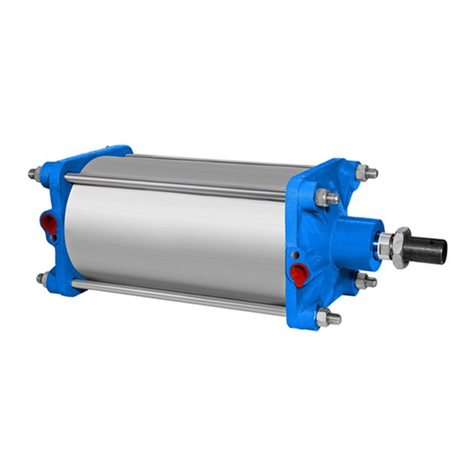
Metso
Metso JAMESBURY CC Series Operating and maintenance manual
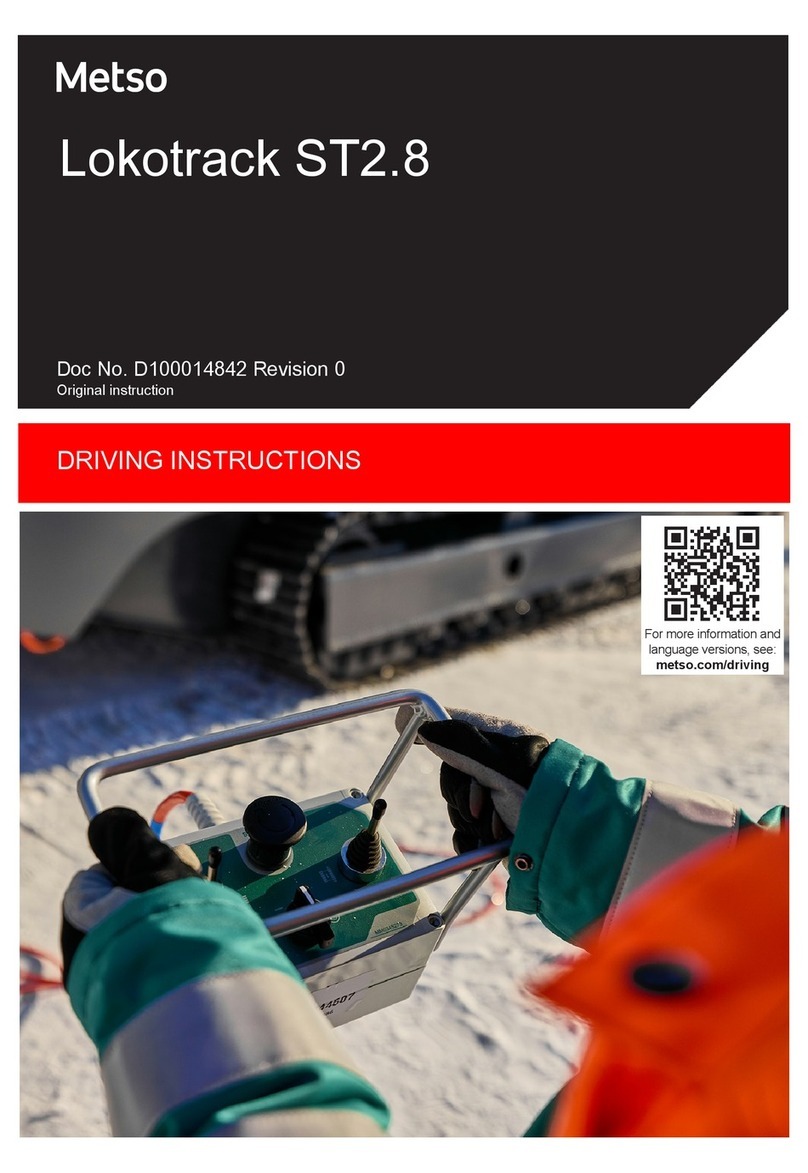
Metso
Metso Lokotrack ST2.8 User manual
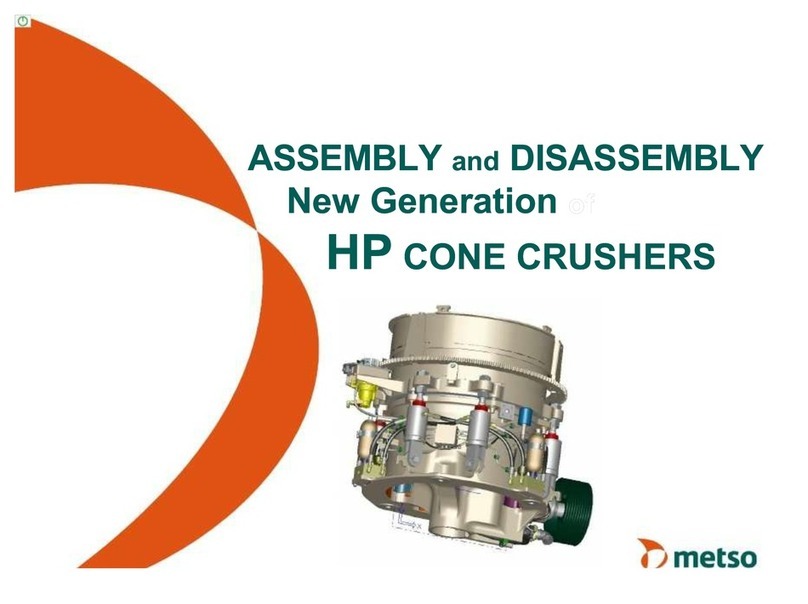
Metso
Metso HP Series Installation instructions

Metso
Metso Nordtrack CT85 User manual
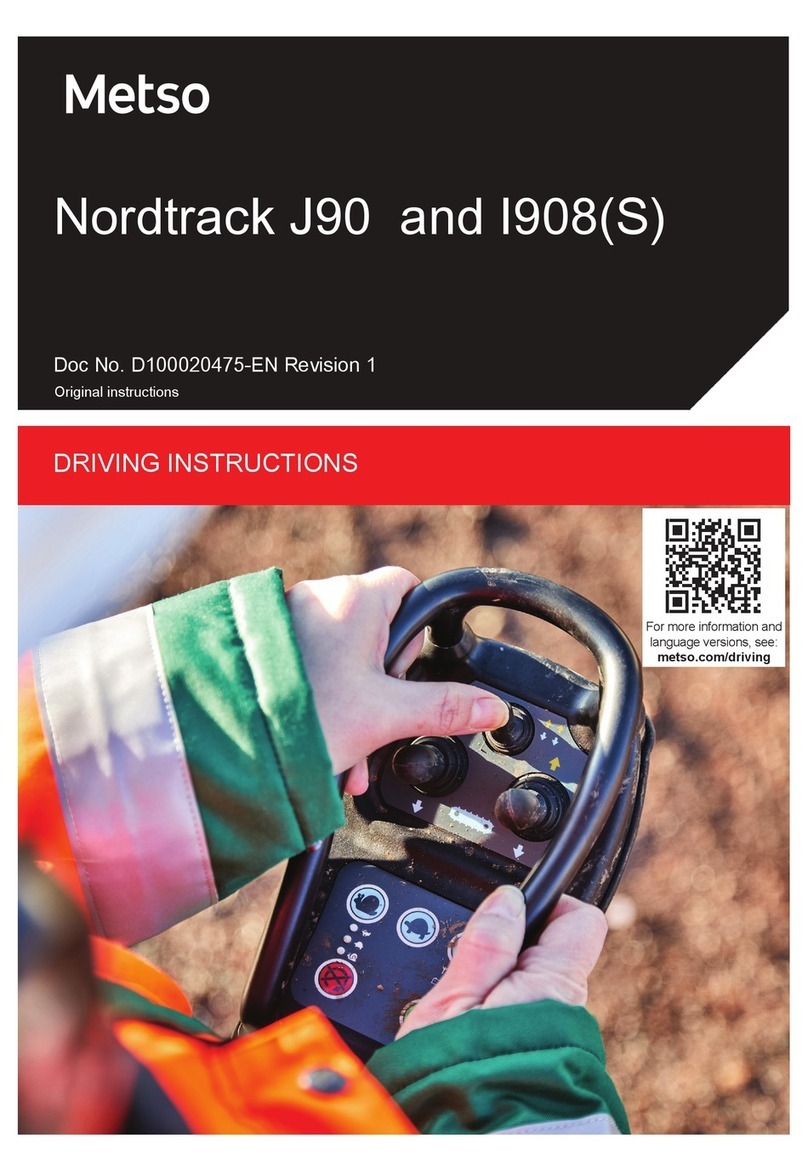
Metso
Metso Nordtrack J90 User manual

Metso
Metso NORDBERG LT105 User manual
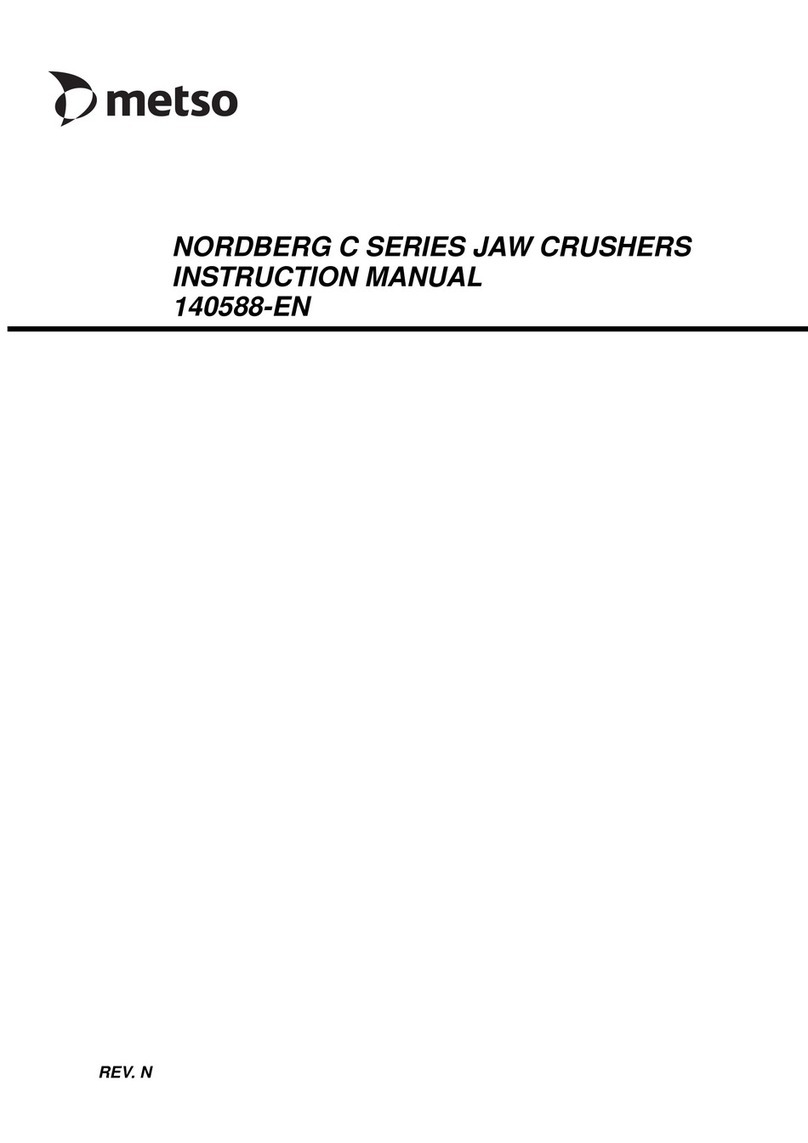
Metso
Metso NORDBERG C Series User manual
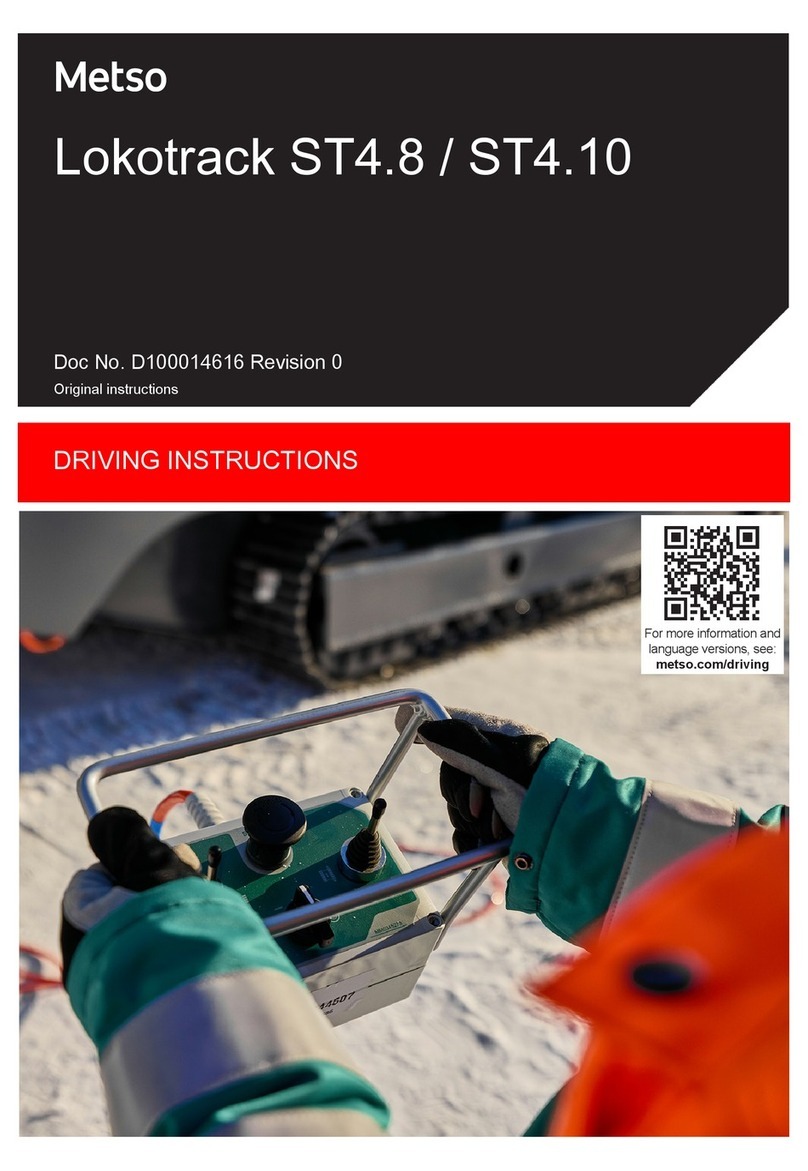
Metso
Metso Lokotrack ST4.8 User manual
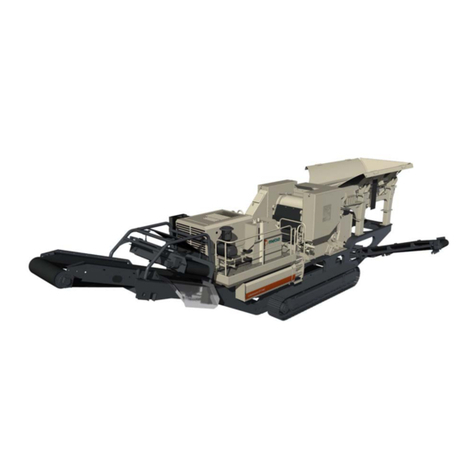
Metso
Metso LOKOTRACK LT110C User manual

Metso
Metso Nordtrack J90 User manual
